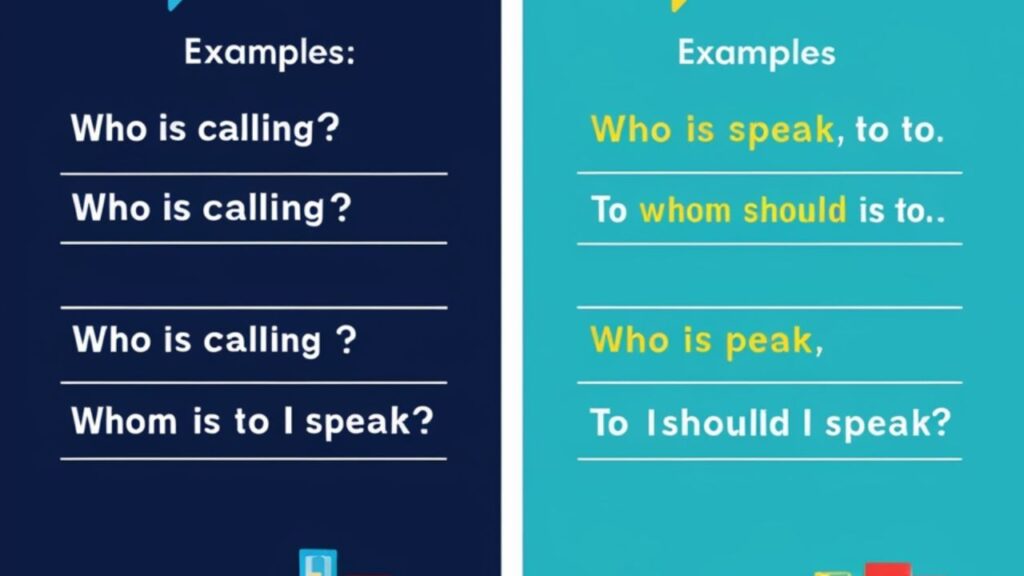Understanding Some of Whom or Some of Who helps young learners use correct English. This phrase explains how we talk about people in a group. When used properly, it makes sentences clear and shows good grammar habits that improve both speaking and writing skills.
Using correct grammar makes your sentences neat and easy to read. The phrase is helpful when you describe part of a group. With simple practice, learners can quickly understand when to use it and how it fits naturally in a sentence.
Learning about English pronouns becomes easier with examples and daily use. Reading and writing short stories using this phrase builds confidence. Step by step, young learners develop strong communication skills and understand language rules more deeply.
Why the Confusion Between “Some of Whom” and “Some of Who” Exists
The mix-up between Some of Whom and Some of Who happens because they look and sound alike. Many learners use them wrongly while speaking or writing fast. Understanding their small difference helps build clear sentences and teaches the right way to express ideas.
In everyday English, people often copy what they hear online or in talks. That habit creates more mistakes. Learning about grammar rules and how each word works in a sentence helps young learners write correctly and speak with confidence.
Refresher: The Core Grammar Rules Behind “Who” vs “Whom”
The words Who and Whom follow simple grammar rules. Who shows the person doing an action, while whom shows the person receiving it. Learning this small rule helps children write correct sentences and understand how each word fits in everyday English.
Practicing English grammar with short examples makes learning fun and easy. When learners use both words correctly, their writing becomes clear and confident. Understanding these rules early builds a strong foundation for good communication and better language skills.
- Who is used for the person doing an action, like in “Who is talking.”
- Whom is used for the person receiving an action, like in “To whom did you give the book.”
- Use who as the subject of a sentence and whom as the object.
- Try the he/him test — if “he” fits, use who; if “him” fits, use whom.
- In formal English, always use whom after prepositions like “to,” “for,” or “with.”
The Role of Prepositions Before “Whom”
Prepositions work closely with whom to show clear meaning in a sentence. Words like “to,” “for,” or “with” come before it to connect ideas. This helps young learners understand how relationships between people or actions are shown in English grammar.
Learning to use prepositions correctly makes writing smooth and natural. When students practice phrases like “to whom” or “with whom,” they understand how words join together. This simple skill improves sentence building and strengthens their confidence in using proper grammar.
| Preposition | Correct Pronoun Example | Explanation |
| of | some of whom | Whom is object of “of” |
| to | to whom | Whom is object of “to” |
| with | with whom | Whom is object of “with” |
| about | about whom | Whom is object of “about” |
“Some of Whom” Is Correct – Here’s Why

The phrase Some of Whom is correct because it follows a clear grammar rule. The word “whom” works as the object after the preposition “of.” This simple rule helps make sentences clear and keeps writing correct in English grammar.
Using proper grammar builds confidence in speaking and writing. When learners understand how words like “of” and “whom” connect, they can form strong and meaningful sentences. Regular practice helps them remember this rule and use it naturally in everyday English.
- The word whom is used as the object after the preposition “of.”
- The phrase refers to people who are part of a larger group.
- It follows the proper grammar rule for prepositions and pronouns.
- Example: “There were ten students, some of whom were absent.”
- Using it correctly shows clear and formal English writing skills.
See also : Who or Whom to Contact? Simple Grammar Guide
Sentence Dissection: How “Some of Whom” Works Grammatically
In English grammar, every part of the phrase “some of whom” has a clear job. “Some” shows a part of a group, “of” joins the words, and “whom” points to people. Together, they create a complete and correct idea.
Learning sentence structure helps young learners see how each word connects. By studying short examples, they understand how grammar rules work in action. This practice strengthens writing skills and makes their communication clearer and more confident.
| Component | Role | Example |
| Some | Quantifier (portion) | Some |
| Of | Preposition | Of |
| Whom | Object pronoun | Whom (object of “of”) |
| Relative Clause | Describes noun | Whom had previous experience |
Real-World Usage: Where You’ll See “Some of Whom”
The phrase Some of Whom appears often in books, news articles, and school lessons. Writers use it to describe people in a group. Seeing it in stories or reports helps learners understand how grammar works in real-life English.
In formal writing, this phrase shows clarity and respect for language rules. Students can notice it in essays, newspapers, or classroom examples. Reading such texts helps them remember the correct usage and apply it easily in their own sentences.
- The phrase often appears in formal writing, such as reports and essays.
- It is common in newspapers and magazines to describe groups of people.
- Writers use it to make sentences clear and grammatically correct.
- It helps show a part of a group in a polite, formal way.
- You can also find it in academic books and professional documents.
“Some of Who” – Why It’s Almost Always Incorrect
The phrase Some of Who is wrong in formal English because “who” cannot follow the preposition “of.” Using “whom” is correct in this place. Knowing this simple grammar rule helps learners write proper and clear sentences.
Many people make this error while speaking or writing fast. Practicing the right form builds good habits. When students remember to use correct English, their writing sounds smoother and more professional in school and other learning tasks.
- The word who cannot follow the preposition “of” in correct grammar.
- The proper form should be “some of whom” when referring to people.
- Using “who” here breaks the object pronoun rule.
- It appears in informal speech but not in formal writing.
- Choosing whom keeps sentences correct, clear, and professional.
How to Easily Decide: Tricks for Choosing “Who” or “Whom”
| Phrase | Use Case | Example |
| Some of whom | Refers to people, formal | “The team, some of whom are new, excels.” |
| Some of them | More general, informal | “The team, some of them are new.” |
- Use who when the word does the action in the sentence.
- Use whom when the word receives the action.
- Try the he/him test — “he” fits with who, “him” fits with whom.
- After prepositions like “to” or “for,” always use whom.
- Rephrase the sentence if unsure; clear structure helps find the correct pronoun.
“Some of Which” and Non-Human References
The phrase Some of Which is used when talking about things or objects, not people. It helps describe a part of a group of items. This small rule in English grammar teaches how words change when we talk about non-human subjects.
Learning the use of which makes writing clear and correct. Students can practice by describing books, toys, or animals. For example, “I saw many birds, some of which were colorful.” Such examples help young learners understand grammar in a simple way.
| Antecedent Type | Correct Phrase | Example |
| People | Some of whom | “The students, some of whom arrived early.” |
| Things/Objects | Some of which | “The files, some of which are confidential.” |
Examples of “Who” and “Whom” in Real Sentences
| Sentence | Correct Usage | Explanation |
| Who is calling? | Who | Subjective case; subject of the verb |
| To whom should I send this? | Whom | Object of preposition “to” |
| She knows who will attend. | Who | Subject of embedded clause |
| The people, some of whom arrived late | Whom | Object of preposition “of” in relative clause |
Common Mistakes English Learners (and Natives) Make
- Using whom instead of who in places where “who” is correct.
- Forgetting to use whom after prepositions like “to” or “with.”
- Replacing all who with whom to sound formal.
- Ignoring grammar rules that show who is the subject or object.
- Copying incorrect spoken English from casual speech or social media.
See also : Same Difference Idiom: Meaning, Examples & Usage
Advanced Grammar Notes for Enthusiasts and Editors

- Relative clauses may shorten in speech, making who and whom harder to spot.
- In ellipsis, missing words can hide the true object, so editors must check carefully.
- Prepositional placement changes tone; formal writing keeps prepositions before whom.
- Both American and British English follow the same rule, though speech may differ.
- Editors should maintain consistency in pronoun use to keep writing precise and clear.
Case Studies: Correct Usage in Editing and Copywriting
In editing and copywriting, correct grammar makes writing clear and professional. Editors check every word to keep meaning accurate. They change mistakes like “some of who” to “some of whom.” This careful work improves the quality of English writing.
Good writers learn these corrections through practice and examples. They study real sentences and fix small grammar issues. With time, learners understand how correct word use builds trust in reading materials and makes every piece look polished and easy to follow.
Key Takeaways and Fast Grammar Reference
| Situation | Correct Phrase | Tip |
| Object of preposition (people) | Some of whom | Use whom after prepositions |
| Subject of clause | Some of who | Use who only as subject |
| Object or subset of things | Some of which | Use which for objects/things |
| General informal reference | Some of them | Common in speech, less formal |
Final Thoughts
Learning English grammar becomes easier with practice and patience. Understanding small rules like when to use “who” or “whom” helps build confidence. With regular reading and writing, learners improve their language skills and start using correct forms naturally in sentences.
Strong communication skills grow through simple daily practice. When students write short stories or answer exercises, they remember grammar rules better. Clear writing not only shows knowledge but also helps express thoughts easily and correctly in every situation.
FAQs
How to Use Who or Whom
Use who for the person doing an action and whom for the person receiving it. This rule helps write correct sentences.
Which Sentence Correctly Uses Who or Whom
Correct example: “To whom did you speak?” Incorrect: “To who did you speak?” Whom follows prepositions or verbs needing an object.
Why Is Whom Not Used Anymore
People often use who instead of whom in daily speech because it sounds simpler and fits better in modern communication.
Do You Put a Comma Before Some of Which
A comma comes before some of which when it adds extra information. It separates useful but not essential sentence details clearly.

Join Bibcia on a journey to master English grammar. Discover easy lessons, writing tips, and practical examples designed to make learning grammar simple and effective.










